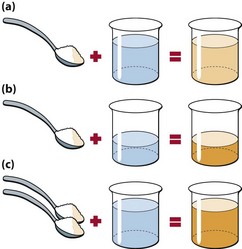3 Most biochemical analyses are quantitative, although simple qualitative or semi-quantitative tests, such as those for the presence of glucose in urine, are commonly encountered methods used for point of care testing. Many tests measure the amount of the analyte in a small volume of blood, plasma, serum, urine or some other fluid or tissue. Results are reported as concentrations, usually in terms of the number of moles in one litre (mol/L) (Table 3.1). Table 3.1 The concept of concentration is illustrated in Figure 3.1. The concentration of any analyte in a body compartment is a ratio: the amount of the substance dissolved in a known volume. Changes in concentration can occur for two reasons: Fig 3.1 Understanding concentrations. Concentration is always dependent on two factors: the amount of solute and the amount of solvent. The concentration of the sugar solution in the beaker can be increased from 1 spoon/beaker (a) to 2 spoons/beaker by either decreasing the volume of solvent (b) or increasing the amount of solute (c).
The interpretation of results
How biochemical results are expressed
Mole
Abbreviation
Definition
Millimole
mmol
×10−3 of a mole
Micromole
µmol
×10−6
Nanomole
nmol
×10−9
Picomole
pmol
×10−12
Femtomole
fmol
×10−15

 The amount of the analyte can increase or decrease.
The amount of the analyte can increase or decrease.
 The volume of fluid in which the analyte is dissolved can similarly change.
The volume of fluid in which the analyte is dissolved can similarly change.
The interpretation of results







